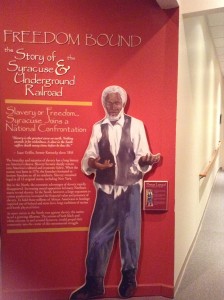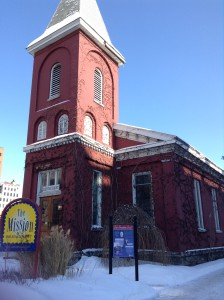
An older picture of the first black church of Syracuse, AME Zion Church, built by fugitive slave Jermain Loguen in 1910. Courtesy of Save 711 AME Zion, 2014.
For runaway slaves, the AME Zion Church in downtown Syracuse was a stop on the underground railroad. Now it is among the sites in Syracuse that is a tourist attraction during Black History Month.
AME Zion Church was the first black church of Syracuse, organized in 1835 by fugitive slave the Rev. Thomas James. The building that stands now was built in 1910 on East Fayette Street.
Dennis Connors is the curator of history at the Onondaga Historical Association. The church and the community of Syracuse was a major stop on the underground railroad, Connors said.
“Syracuse was very important to the underground railroad for many reasons. One was certainly location- in the north slaves used regular transportation routes and Syracuse had good transportation connections, rails and canals. Second, upstate was an area where a lot of activity of progressive reform and strong support. Third, a very important part was the presence of Jermain Loguen known as a ‘station master,’ whose house and contacts were main underground railroad activity,” said Connors.

An informational wall at the Onondaga Historical Association about Syracuse’s part in the Freedom Bound Movement. Photo by Shantinique Brooks.
Connors recommends visitors visit three other major black historical attractions in Syracuse. They are the Onondaga Historical Association, The Mission Restaurant that was formerly the Wesleyan Methodist Church and The Jerry Rescue Monument.
Spike Herzig is a former tour operator and now the founder and president of the New York Cultural Heritage Tourism Network in Syracuse, which puts together historical site packages for visitors and educates businesses on how to host those visitors. The network is made up of 115 members. The network’s goal is to market the cultural attractions to drive more business into upstate New York.
For Black History Month, the network sells underground railroad tours. But the weather is an obstacle, said Herzig.
“Exclusively we sell probably less than 10 Underground Railroad tour packages in February. But we do very well with better weather. I would say about 75 packages, which is about 150 people, would buy our Underground Railroad Package during the year,” says Herzig.
Other stops and attractions along Syracuse’s Underground Railroad include:
- The Courier Building at 110 Montgomery St.
This is where, in 1841, United States Secretary of State Daniel Webster announced the enforcement of the Fugitive Slave Law’s enforcement in Syracuse. This law made it legal for slave owners to come north and recapture fugitive slave though slaves were free once in the north. This law led to the Jerry Rescue, in which whites helped rescue a fugitive slave named Jerry from a Syracuse jail.
- Wesleyan Methodist Church , now The Mission Restaurant, at 304 E. Onondaga St.
This is a church with artifacts, now presevred at the Onondaga Historical Association, dating back to the 19th Century. The association found aged rocks with carving that suggests runaway slaves may have hidden in the building’s basement for shelter.
- The Jerry Rescue monument at Clinton Square
This monument now stands on the site of the 1851 Syracuse police station where a former slave named William “Jerry” Henry was held because of the Fugitive Slave Act. Syracuse abolitionists broke him out of jail in one of the successful rebellions against the law.
- The Robinsons houses at 204 and 206 Catherine St.
These homes were owned by Mary Robinson, whose descendants took over the homes and neighborhoods, one of the first black organized communities in Syracuse on the north side. The neighborhood consisted of black domestic workers, barbers, laborers and boatmen. - The Harriet May Mills house at 1074 W. Genesee St. According to the Preservation Association of Central New York, oral tradition says that this was a safe house on the underground railroad.
(Shantinique Brooks is a senior majoring in broadcast and digital journalism with a political science minor.)
-30-



